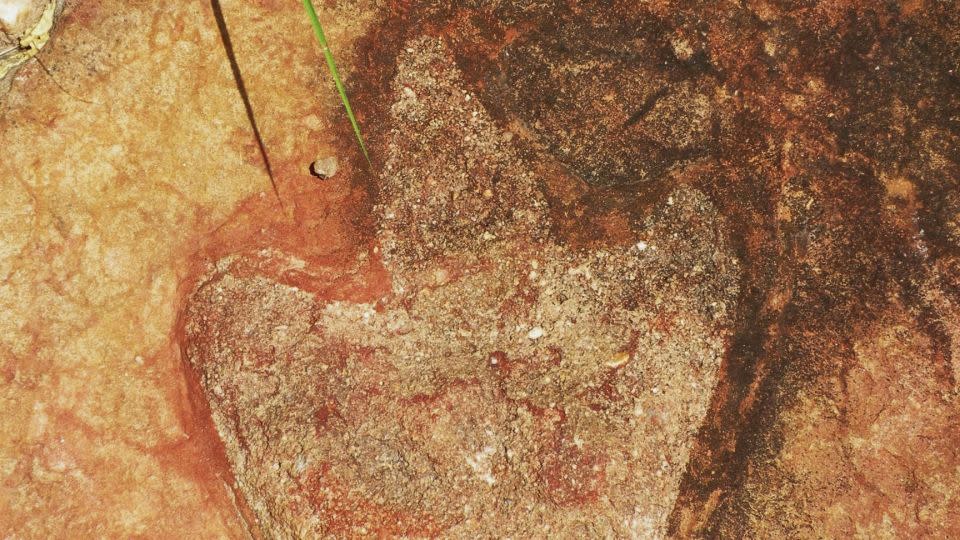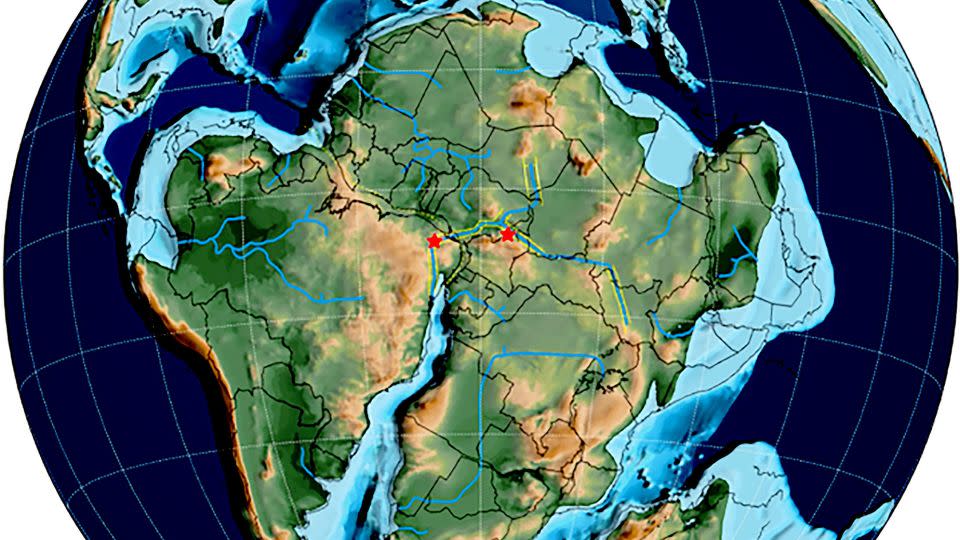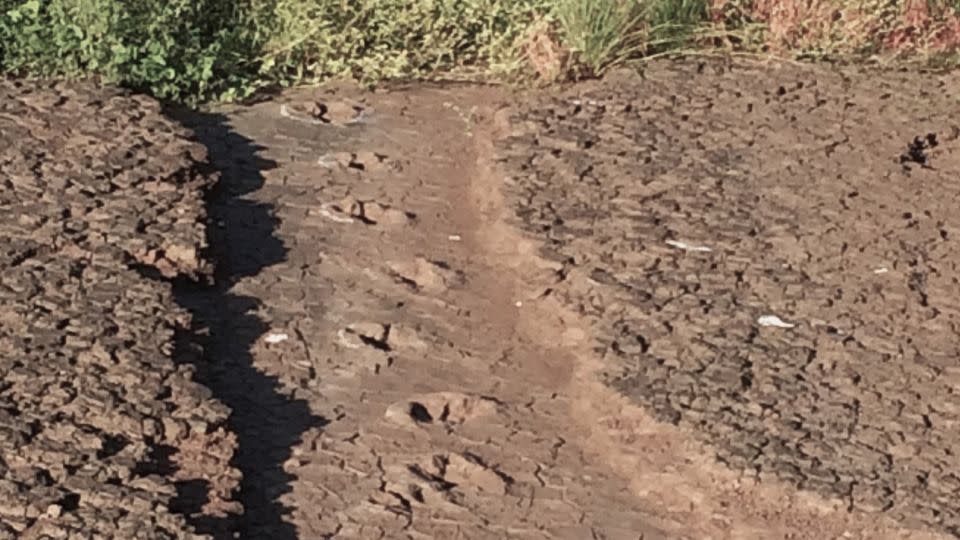Sign up for CNN’s Wonder Theory science newsletter. Explore the universe with news about fascinating discoveries, scientific developments and more.
New research shows that matching sets of footprints found in Africa and South America show that dinosaurs traveled along a kind of highway 120 million years ago, before the two continents separated.
Paleontologists have found more than 260 dinosaur footprints from the Early Cretaceous in Brazil and Cameroon. The tracks are now more than 6,000 kilometers apart, on opposite sides of the Atlantic Ocean.
The footprints are similar in age, shape and geological context, said Louis L. Jacobs, a paleontologist at Southern Methodist University in Texas and lead author of a study describing the tracks published Monday by the New Mexico Museum of Natural History & Science.

Most of the fossilized prints were made by three-toed theropod dinosaurs, while a few likely belonged to lumbering, four-legged sauropods with long necks and tails or to ornithischians, whose pelvic structures resemble those of birds, said study co-author Diana P.
Vineyard, research associate at SMU.
The tracks tell the story of how the movements of huge land masses created ideal conditions for dinosaurs before supercontinents broke up into the seven continents we know today.
Lush pools for life
The footprints are preserved in mud and silt along ancient rivers and lakes that once covered the supercontinent Gondwana, which broke away from the larger land area of Pangaea, Jacobs said.
“One of the youngest and narrowest geologic connections between Africa and South America was the elbow of northeastern Brazil, nestled against what is now the coast of Cameroon along the Gulf of Guinea,” Jacobs said. “The two continents were connected along that narrow stretch, so animals on either side of that connection could potentially move across it.”
Africa and South America began to separate about 140 million years ago. The separation caused cracks in the Earth’s crust, and as the tectonic plates moved away from South America and Africa, magma in the mantle created new oceanic crust. Over time, the South Atlantic Ocean filled the space between the two continents.


But before this gradual change occurred, different types of basins formed as the Earth’s surface pulled apart. Rivers emptied into the basins and formed lakes, Jacobs said.
The study authors found evidence for what is known as a half-graben basin in the Borborema region of northeastern Brazil and a similar basin in the Koum Basin of northern Cameroon.
“A half graben is an elongated basin formed by the Earth’s surface pulling apart with a fault forming on one side, so that the valley floor slopes down toward the fault along which movement is occurring,” Jacobs said by email. “Hold your hand out in front of you. Tilt your fingers down, representing movement along the fault. Rivers will flow down the valley and deposit sediments, and sediments will be eroded from the high side of the valley.”
In both basins, the researchers found dinosaur tracks, ancient river and lake sediments, and fossilized pollen.
“Plants fed the herbivores and supported a food chain,” he said. “Muddy sediments left by rivers and lakes contain dinosaur footprints, including those of carnivores, proving that these river valleys could have provided specific pathways for life to travel across the continents 120 million years ago.”
While dinosaur fossils can provide unique insights into the types of animals that lived on Earth millions of years ago, their footprints offer even greater insight into the past.
“Dinosaur tracks are not rare, but unlike the bones that are typically found, footprints are evidence of dinosaur behavior, how they walked, ran or otherwise, who they walked with, what environment they walked in, what direction they walked in and where they were when they did it,” Jacobs said.
It’s difficult to say which specific types of dinosaurs passed through the basins, but they do provide a better picture of ancient climates and how different species thrived in the environments created by the continental rifts.
“If your dog and a coyote are walking across the same mudflat, you might know that two dog animals have walked across that mudflat, that they look very similar, but you might not know that they are different species. The same is true for the dinosaur tracks,” Jacobs said. “All animals have a home range. All animals expand their home ranges. All animals exploit resources as needed, depending on availability, often related to seasonality. Herbivores follow nutritious plants; carnivores follow their herbivorous food.”
At that time, rainfall levels helped create a tropical rainforest-like environment with abundant vegetation. Animals came to the basins from both present-day Africa and South America, causing their populations to mix.
“Imagine a lush, open basin with vegetation for the herbivores and carnivores that follow,” said study co-author Lawrence Flynn, assistant director of the American School of Prehistoric Research and coordinator of lab safety in the department of human evolutionary biology at Harvard University. “If no one is on the ‘new’ terrain, animals will spread out into it, if there is no competition.”


Later, as the continents drifted apart, this disruption likely caused a break in genetic continuity, a key driver of evolution, Jacobs said.
The first dinosaur tracks in Cameroon were discovered in the late 1980s. Jacobs reported on them in 1986 at the First International Symposium on Dinosaur Tracks and Traces, organized by paleontologist Martin Lockley.
Jacobs then became friends with study author Ismar de Souza Carvalho, now a professor in the geology department of the Federal University of Rio de Janeiro. Jacobs studied dinosaur movements from the African side, while Carvalho studied them from the Brazilian side.
As research into the basins in Africa and South America continued in the decades that followed, Jacobs and Carvalho and their colleagues reviewed existing and new fieldwork and research to analyze the similarities. The new study is published as a tribute to Lockley, who devoted his career to studying dinosaur footprints.
“We wanted to bring together new and evolving geological and paleontological evidence to tell a more specific story about where, why and when the dispersal between continents occurred,” Jacobs said.
“One of the beautiful things about this planet is that we can all see that Africa and South America used to fit together like puzzle pieces. It’s easy to imagine that in a connected world, animals, including dinosaurs, could and would move from one place to another.”
For more CNN news and newsletters, create an account at CNN.com